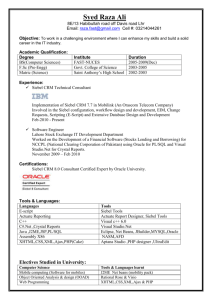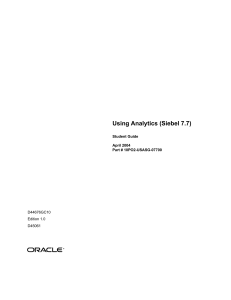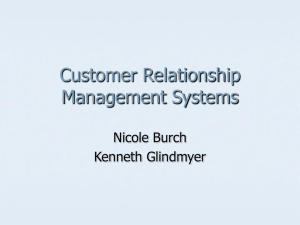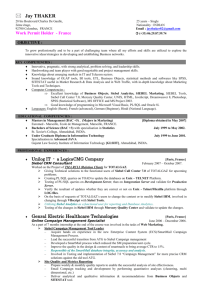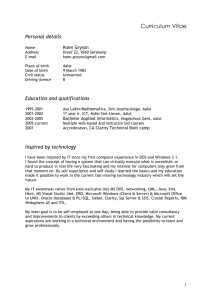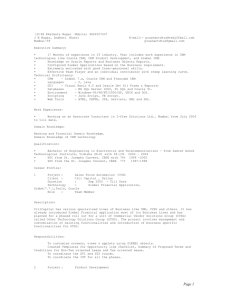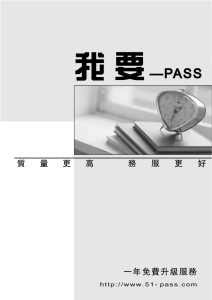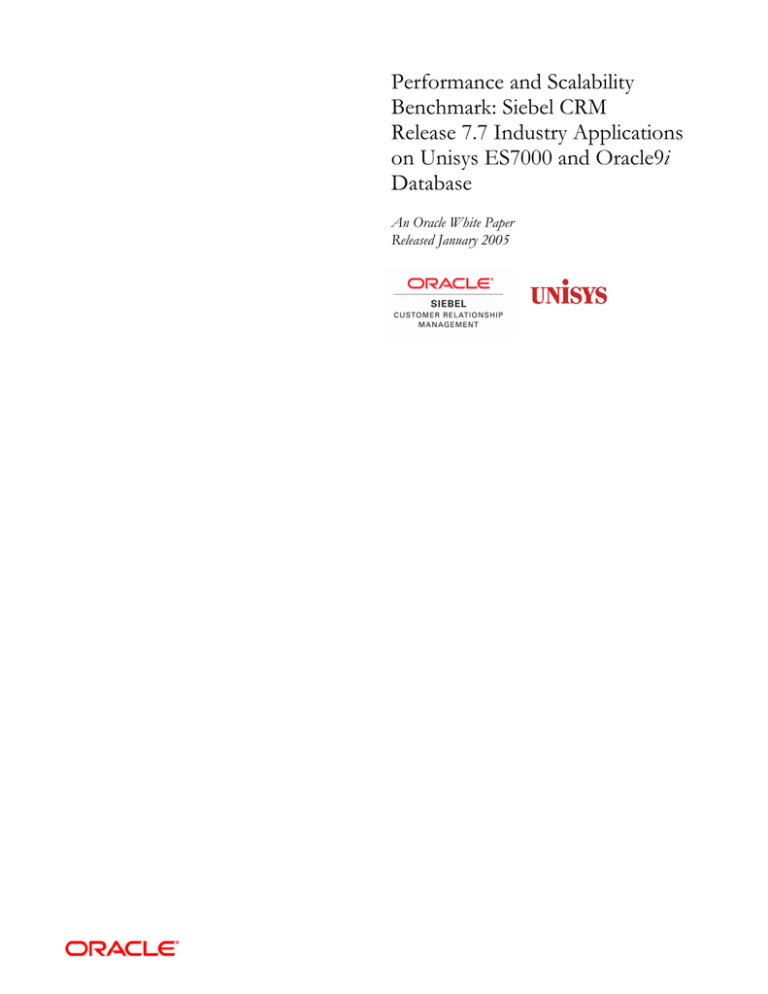
Performance and Scalability
Benchmark: Siebel CRM
Release 7.7 Industry Applications
on Unisys ES7000 and Oracle9i
Database
An Oracle White Paper
Released January 2005
Performance and Scalability Benchmark: Siebel CRM
Release 7.7 Industry Applications on Unisys ES7000
and Oracle9i Database
INTRODUCTION
This white paper describes the performance and scalability capabilities of Oracle’s
Siebel Customer Relationship Management (CRM) Applications Release 7.7. The
benchmark comprised 18,000 concurrent users running Siebel CRM
Release 7.7 industry applications on Unisys ES7000 and Oracle9i Database.
The Siebel Platform Sizing and Performance Program is a test suite certified by
Siebel and executed independently by Unisys. Unisys completed the benchmark on
January 5, 2005; Siebel certified it on January 14, 2005. Note that this benchmark
data is intended for general information purposes and not as a substitute for
implementation-specific sizing or benchmarks.
Results Summary: 18,000-Concurrent-User Benchmark
Workload
Financial Services Call Center
Partner Relationship Management
EAI – HTTP Adapter
Totals
Number
of Users
Average
Operation
Response
Time (sec)
1 2
Business
Transactions
Throughput/hour
Projected
Daily
Transactions
14,400
0.40
117,170
3,600
0.50
78,757
630,056
N/A
N/A
469,057
3,752,456
664,984
5,319,872
18,000
937,360
1 Actual results may vary, based on a broad range of implementation-specific factors,
such as transaction mix, hardware platform, network parameters, and database size.
Oracle does not warrant or guarantee that customers will obtain the same or similar
results, even if they use the same or similar equipment and/or software applications.
Oracle does not warrant, endorse, or guarantee any performance of any products, any
results desired or achieved, or any statements made within this document.
2 Siebel CRM Release 7.7 Industry Application Platform Sizing and Performance
benchmarks are based on Siebel CRM Release 7.7 customized industry applications and
reflect a heavier scenario mix and more-aggressive think times than earlier versions.
Results of this benchmark are not comparable with those of prior Siebel CRM
Release 7 benchmarks.
Performance and Scalability Benchmark: Siebel CRM Release 7.7 Industry Applications on Unisys Page 2
Test Component
Software
Version
Hardware
Database Server
Oracle 9i
9.2.0.4
Unisys ES7000/420
Application Servers
Siebel
7.7.1
Unisys ES7000/520
Web Servers
MS IIS
6.0
Unisys ES7000/520
OS
Windows 2003
Datacenter 64-bit
Windows 2003
Datacenter 32-bit
Windows 2003
Enterprise Edition
OVERVIEW
Siebel CRM Release 7.7 uses the enhanced Siebel CRM Release 7 Smart Web
architecture, which introduced a new approach to Web applications. This
architecture improves scalability while making efficient use of both network and
Web server resources, allowing customers to use their existing network and Web
server infrastructure.
The Siebel Platform Sizing and Performance Program is designed to stress the
Siebel CRM Release 7.7 architecture and to demonstrate the performance and
scalability of the application in a business solution context. Among the Siebel CRM
Release 7.7 architecture features exercised are the following:
•
Smart Web Architecture—Takes advantage of the newest Web browser
technology to deliver a highly interactive experience. The interaction model,
which is similar to Windows-based applications, also improves productivity.
Utilization rates on the Web server are low, allowing customers to retain
existing Web server infrastructure.
•
Smart Network Architecture—Allows Siebel CRM Release 7 customers to
leverage their existing network infrastructure by compressing and caching
user interface components, so that browser/Web server interaction occurs
only when the application requests data. This allows customers to avoid
expensive network upgrades that can be necessary with competing products.
•
Server Connection Broker—Offers a preconfigured load-balancing option
while also supporting a hardware-based solution. Resonate Central Dispatch
may be used in Siebel CRM Release 7.7, but it is not required. In addition,
the new Siebel Connection Broker component distributes tasks between
multiple processes, improving intraprocess load-balancing characteristics.
•
Smart Database Connection Pooling and Multiplexing—Allows
customers to scale their databases without introducing expensive and
complex transaction-processing monitors.
•
Server Request Broker—Provides component-level load balancing across
multiple Siebel servers, without the expense and complex administration of
transaction-processing monitors.
Performance and Scalability Benchmark: Siebel CRM Release 7.7 Industry Applications on Unisys Page 3
•
Enterprise Application Integration—Allows customers to integrate their
existing systems with Siebel CRM applications.
This test simulated a large corporation with 18,000 concurrent active users in
multiple departments and addressed key business requirements.
•
Siebel Financial Services Call Center—Provides the most complete
solution for sales and service, allowing customer service and telesales
representatives to provide superior customer support, improve customer
loyalty, and increase revenues through cross-selling and up-selling.
•
Siebel Partner Relationship Management—Enables organizations to
effectively and strategically manage relationships with partners, distributors,
resellers, agents, brokers, and dealers.
•
Siebel Workflow—Automates user interaction, business processes, and
integration through use of a business-process-management engine. It allows
simple administration and customization through a graphical drag-and-drop
user interface. Administrators can add custom or predefined business
services and specify logical branching, updates, inserts, and subprocesses to
create a workflow process tailored to their unique business requirements.
•
Siebel Enterprise Application Integration (EAI)—Allows customers to
integrate their existing applications with Siebel CRM applications. Siebel EAI
supports several adapters. The Siebel EAI HTTP Adapter was used in this
benchmark.
METHODOLOGY
This benchmark was executed independently by Unisys under the Siebel CRM
Release 7.7 Industry Applications Platform Sizing and Performance Program
guidelines. Test cases are based on Siebel customer requirements and exercise
some of the most critical and frequently used components of the Siebel CRM
application. The test cases must run in steady state for at least one hour, and
certification is dependent on the achievement of certain key performance
indicators.
The test simulated real-world requirements of a large organization, consisting of
18,000 concurrent, active users in a call center organization. Test conditions
simulated service representatives running Siebel Financial Services Call Center, and
partner organizations running Siebel Partner Relationship Management (Web sales
and Web Service.
Siebel Workflow and the Siebel Scripting Engine were used to incorporate
business-process-management customizations.
The application also simulated integration with Web systems, using the Siebel
Enterprise Application Integration component and the Siebel HTTP Adapter. In
this case, an eight-hour business day included more than 3,700,000 EAI
transactions between systems.
Performance and Scalability Benchmark: Siebel CRM Release 7.7 Industry Applications on Unisys Page 4
End users were simulated by use of Mercury LoadRunner version 8. The thinktime range between user operations was 13 to 23 seconds. The Siebel CRM Release
7.7 Scripting Engine was invoked to assign service requests and navigate the user
to the appropriate views. Siebel CRM Release 7.7 Workflow Manager executed
workflow steps based on inserted service requests. The Siebel CRM Release 7.7
EAI HTTP Adapter executed requests between different Web infrastructures.
Database Setup
Prior to benchmark execution, the database size was approximately 230GB. It was
constructed based on Siebel customer experience and requirements and was based
on the Siebel CRM Industry Application repository and data model—representing
the most common data distribution and volumes in high-transaction-rate
implementations. The table below shows a sampling of record volumes for key
business entities in the Siebel Industry Application volume database.
Business Entity
Number of Records
Accounts
2,233,637
Activities
6,685,419
Addresses
3,475,662
Contacts
3,521,040
Employees
Opportunities
Orders
Products
Quote Items
Quotes
Service Requests
30,000
3,429,952
496,909
230,102
1,984,252
253,693
5,651,814
Business Transactions
Several complex business transactions were executed simultaneously for 18,000
concurrent users. Between each user operation and the next one, the think-time
range was 13 to 23 seconds. This section describes the cases tested.
Siebel Financial Services Call Center—Create and Assign Service Requests
•
Service agent searches for contact.
•
Service agent checks entitlements.
•
Service request is created.
•
Service agent populates service request with appropriate detail.
•
Service agent creates activity plan to resolve issue.
•
Using Siebel Script, the service request is automatically assigned to
appropriate representative to address issue.
Siebel Partner Relationship Management—Sales and Service
Performance and Scalability Benchmark: Siebel CRM Release 7.7 Industry Applications on Unisys Page 5
•
Partner creates new service request with appropriate detail.
•
Service request is automatically assigned.
•
Saving service request invokes scripting that brings user to the appropriate
opportunity screen.
•
New opportunity with detail is created and saved.
•
Saving opportunity invokes scripting that brings user back to service request
screen.
Siebel Enterprise Application Integration—Integrate Third-Party
Application
•
EAI requests are made using a customized account-integration object. The
requests consist of 80 percent selects, 10 percent updates, and 10 percent
inserts are processed.
The use cases are typically considered heavy transactions. For example, the highlevel description of the sequential steps for the “Create and Assign Service
Requests” use case is as follows:
•
Enable Siebel Search Center.
•
Search for a contact.
•
Review contact detail and create a new service request.
•
Add details to the service request.
•
From the service request view, search for an account.
•
Select an account and associate it with the service request.
•
Navigate to the verify tab and select entitlements.
•
Verify entitlements and continue service request investigation.
•
Search for insurance group; select the appropriate policy and product.
•
Create a new contact, entering information into all of the fields in the list
view.
•
Complete service request details and save the service request.
•
Select the activity plan option and automatically generate an activity plan for
the service request.
•
Scripting will automatically assign the service request.
•
Summarize the service request with the customer.
Topology
This section describes the hardware topology of the systems used for the test, as
well as the hardware and software combinations used.
Performance and Scalability Benchmark: Siebel CRM Release 7.7 Industry Applications on Unisys Page 6
Database server:
•
1x ES7000 Aries 420
o
16x 1.6 GHz Itanium 2
o
64GB RAM
o
Oracle9i Database Release 9.2.0.4
o
Microsoft Windows 2003 Datacenter
Web servers:
•
4x ES7000 Orion 520
o
8x 2.2 GHz Intel Xeon MP
o
16GB RAM
o
Microsoft Windows 2003 Enterprise Edition
Siebel application servers:
•
7x ES7000 Orion 520
o
16x 3.0 GHz Intel Xeon MP
Performance and Scalability Benchmark: Siebel CRM Release 7.7 Industry Applications on Unisys Page 7
o
28GB RAM
o
Siebel CRM Release 7.7.1
o
Microsoft Windows 2003 Datacenter
LoadRunner drivers:
•
6x ES7000 Orion 520
o
8x 2.2 GHz Intel Xeon MP
o
16GB RAM
o
Microsoft Windows 2003 Enterprise Edition
o
Mercury LoadRunner v8
RESULTS
Response Time and Transaction Throughput
Number
of Users
Workload
Financial Services Call Center
Average
Operation
Response
Time (sec)
Business
Transactions
Throughput/hour
Projected
Daily
Transactions
14,400
0.40
117,170
3,600
0.50
78,757
630,056
N/A
N/A
469,057
3,752,456
664,984
5,319,872
Partner Relationship Management
EAI – HTTP Adapter
Totals
3 4 5
18,000
937,360
Server Resource Utilization
Node
Users
Functional Use
% CPU
Memory
Utilization
(GB)
520 8X
4,500
Web Server
86
1
520 8X
4,500
Web Server
83
2
520 8X
4,500
Web Server
92
2
520 8X
4,500
Web Server
75
2
520 16X
2885
Siebel Application Server
87
17
520 16X
2900
Siebel Application Server
87
18
520 16X
2917
Siebel Application Server
88
17
3
Response times are measured at the Web server instead of at the end user. The
response times at the end user would depend on the network latency, the bandwidth
between Web server and browser, and the time for browser rendering of content.
4 A business transaction is a defined set of steps, activities, and application interactions
used to complete a business process, such as “Create and Assign Service Requests.”
“Search for a contact” is an example of a step in a business transaction. For a detailed
description of business transactions, see the “Business Transactions” section.
5 Actual results may vary, based on a broad range of implementation-specific factors,
such as transaction mix, hardware platform, network parameters, and database size.
Oracle does not warrant or guarantee that customers will obtain the same or similar
results, even if they use the same or similar equipment and/or software applications.
Oracle does not warrant, endorse, or guarantee any performance of any products, any
results desired or achieved, or any statements made within this document.
Performance and Scalability Benchmark: Siebel CRM Release 7.7 Industry Applications on Unisys Page 8
520 16X
2898
Siebel Application Server
87
17
520 16X
2900
Siebel Application Server
87
18
520 16X
2900
Siebel Application Server
85
17
520 16X
605
Siebel App & HTTP Server
40
5
420 16X
18,000
Oracle9i Database
91
23
Network Utilization
For 18,000 concurrent users, the network utilization measured was 45.85 Mbps for
the browser traffic, an average of 2.55 Kbps per user. These measurements
incorporated compression for Web-server-to-browser traffic.
CONCLUSION
The test system demonstrated that Oracle’s Siebel CRM Release 7.7 architecture
on Unisys ES7000 and Oracle9i Database easily scales to 18,000 concurrent users.
•
Vertical scalability—The Siebel CRM Release 7.7 server showed excellent
scalability within an application server.
•
Horizontal scalability—The benchmark demonstrated scalability across
multiple servers without degradation.
•
Low network utilization—The Siebel CRM Release 7.7 Smart Web
Architecture and Smart Network Architecture efficiently managed the
network, consuming only 2.55 kilobits per second per user.
•
Efficient use of the database server—Siebel CRM Release 7.7 Smart
Database Connection Pooling and Multiplexing allowed the database to
service 18,000 concurrent users and the supporting Siebel CRM Release 7.7
server application services with 957 database connections. To optimize
database server resources, a 20:1 ratio of users-database connections was
used for Siebel Smart Database Connection Pooling and Multiplexing.
Released January 14, 2005
Performance and Scalability Benchmark: Siebel CRM Release 7.7 Industry Applications on Unisys Page 9
Performance and Scalability Benchmark: Siebel CRM Release 7.7
Industry Applications on Unisys ES7000 and Oracle9i Database
Released January 2005
Oracle Corporation
World Headquarters
500 Oracle Parkway
Redwood Shores, CA 94065
U.S.A.
Worldwide Inquiries:
Phone: +1.650.506.7000
Fax: +1.650.506.7200
oracle.com
Copyright © 2005, 2006, Oracle. All rights reserved.
This document is provided for information purposes only and the
contents hereof are subject to change without notice.
This document is not warranted to be error-free, nor subject to any
other warranties or conditions, whether expressed orally or implied
in law, including implied warranties and conditions of merchantability
or fitness for a particular purpose. We specifically disclaim any
liability with respect to this document and no contractual obligations
are formed either directly or indirectly by this document. This document
may not be reproduced or transmitted in any form or by any means,
electronic or mechanical, for any purpose, without our prior written permission.
Oracle, JD Edwards, PeopleSoft, and Siebel are registered trademarks of Oracle
Corporation and/or its affiliates. Other names may be trademarks
of their respective owners.

